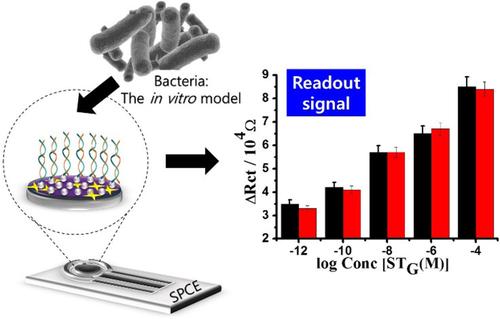当前位置:
X-MOL 学术
›
Electroanalysis
›
论文详情
Our official English website, www.x-mol.net, welcomes your
feedback! (Note: you will need to create a separate account there.)
Highly Sensitive In Vitro Biosensor for Enterotoxigenic Escherichia coli Detection Based on ssDNA Anchored on PtNPs-Chitosan Nanocomposite
Electroanalysis ( IF 2.7 ) Pub Date : 2017-09-19 , DOI: 10.1002/elan.201600169 Kashish 1 , Surbhi Bansal 2 , Anurag Jyoti 2 , Kuldeep Mahato 3 , Pranjal Chandra 3 , Rajiv Prakash 1
Electroanalysis ( IF 2.7 ) Pub Date : 2017-09-19 , DOI: 10.1002/elan.201600169 Kashish 1 , Surbhi Bansal 2 , Anurag Jyoti 2 , Kuldeep Mahato 3 , Pranjal Chandra 3 , Rajiv Prakash 1
Affiliation

|
Detection of Enterotoxigenic Escherichia coli in various biological samples has tremendous importance in human health. In this direction, we have designed a label free electrochemical biosensor for highly selective detection of Escherichia coli through detecting ST gene. The ability of sensor probe to detect STG was confirmed using polymerase chain reaction. The biosensor was fabricated based on STG specific probes immobilized on platinum nanoparticles chitosan nanocomposite on screen printed carbon electrode, which was characterized by cyclic voltammetry, transmission electron microscopy, and fourier transform infrared spectroscopy. A highly sensitive label free sensing was achieved by analyzing STG hybridization using electrochemical impedance spectroscopy (EIS) technique. The EIS analysis showed a significant increase in charge transfer resistance after STG interaction with the highly selective ssDNA probe immobilized on the nanocomposite film. The increase in charge transfer resistance was evaluated for varying concentrations of STG, which shows a dynamic range between 1.0×10−12 and 1.0×10−4 with the detection limit of 3.6×10−14 M (RSD<4.5 %). The regeneration of sensor probe was also studied and interference due to non-target sequences was evaluated to ensure the selectivity of the designed sensor. The practical applicability of sensor probe was also analyzed by detecting the STG from the bacteria present in surface water.
中文翻译:

基于固定在 PtNPs-壳聚糖纳米复合材料上的 ssDNA 的高灵敏度体外生物传感器检测产肠毒素大肠杆菌
检测各种生物样品中的产肠毒素大肠杆菌对人类健康具有极其重要的意义。在这个方向上,我们设计了一种无标记电化学生物传感器,通过检测 ST 基因对大肠杆菌进行高选择性检测。使用聚合酶链反应证实了传感器探针检测 STG 的能力。该生物传感器基于固定在丝网印刷碳电极上的铂纳米颗粒壳聚糖纳米复合材料上的 STG 特异性探针制成,其特征在于循环伏安法、透射电子显微镜和傅立叶变换红外光谱。通过使用电化学阻抗谱 (EIS) 技术分析 STG 杂交,实现了高度灵敏的无标记传感。EIS 分析表明,在 STG 与固定在纳米复合膜上的高选择性 ssDNA 探针相互作用后,电荷转移电阻显着增加。针对不同浓度的 STG 评估了电荷转移电阻的增加,显示动态范围介于 1.0×10-12 和 1.0×10-4 之间,检测限为 3.6×10-14 M (RSD<4.5 %)。还研究了传感器探针的再生,并评估了由于非目标序列引起的干扰,以确保设计的传感器的选择性。还通过检测地表水中存在的细菌的 STG 来分析传感器探头的实际适用性。针对不同浓度的 STG 评估了电荷转移电阻的增加,显示动态范围介于 1.0×10-12 和 1.0×10-4 之间,检测限为 3.6×10-14 M (RSD<4.5 %)。还研究了传感器探针的再生,并评估了由于非目标序列引起的干扰,以确保设计的传感器的选择性。还通过检测地表水中存在的细菌的 STG 来分析传感器探头的实际适用性。针对不同浓度的 STG 评估了电荷转移电阻的增加,显示动态范围介于 1.0×10-12 和 1.0×10-4 之间,检测限为 3.6×10-14 M (RSD<4.5 %)。还研究了传感器探针的再生,并评估了由于非目标序列引起的干扰,以确保设计的传感器的选择性。还通过检测地表水中存在的细菌的 STG 来分析传感器探头的实际适用性。
更新日期:2017-09-19
中文翻译:

基于固定在 PtNPs-壳聚糖纳米复合材料上的 ssDNA 的高灵敏度体外生物传感器检测产肠毒素大肠杆菌
检测各种生物样品中的产肠毒素大肠杆菌对人类健康具有极其重要的意义。在这个方向上,我们设计了一种无标记电化学生物传感器,通过检测 ST 基因对大肠杆菌进行高选择性检测。使用聚合酶链反应证实了传感器探针检测 STG 的能力。该生物传感器基于固定在丝网印刷碳电极上的铂纳米颗粒壳聚糖纳米复合材料上的 STG 特异性探针制成,其特征在于循环伏安法、透射电子显微镜和傅立叶变换红外光谱。通过使用电化学阻抗谱 (EIS) 技术分析 STG 杂交,实现了高度灵敏的无标记传感。EIS 分析表明,在 STG 与固定在纳米复合膜上的高选择性 ssDNA 探针相互作用后,电荷转移电阻显着增加。针对不同浓度的 STG 评估了电荷转移电阻的增加,显示动态范围介于 1.0×10-12 和 1.0×10-4 之间,检测限为 3.6×10-14 M (RSD<4.5 %)。还研究了传感器探针的再生,并评估了由于非目标序列引起的干扰,以确保设计的传感器的选择性。还通过检测地表水中存在的细菌的 STG 来分析传感器探头的实际适用性。针对不同浓度的 STG 评估了电荷转移电阻的增加,显示动态范围介于 1.0×10-12 和 1.0×10-4 之间,检测限为 3.6×10-14 M (RSD<4.5 %)。还研究了传感器探针的再生,并评估了由于非目标序列引起的干扰,以确保设计的传感器的选择性。还通过检测地表水中存在的细菌的 STG 来分析传感器探头的实际适用性。针对不同浓度的 STG 评估了电荷转移电阻的增加,显示动态范围介于 1.0×10-12 和 1.0×10-4 之间,检测限为 3.6×10-14 M (RSD<4.5 %)。还研究了传感器探针的再生,并评估了由于非目标序列引起的干扰,以确保设计的传感器的选择性。还通过检测地表水中存在的细菌的 STG 来分析传感器探头的实际适用性。











































 京公网安备 11010802027423号
京公网安备 11010802027423号